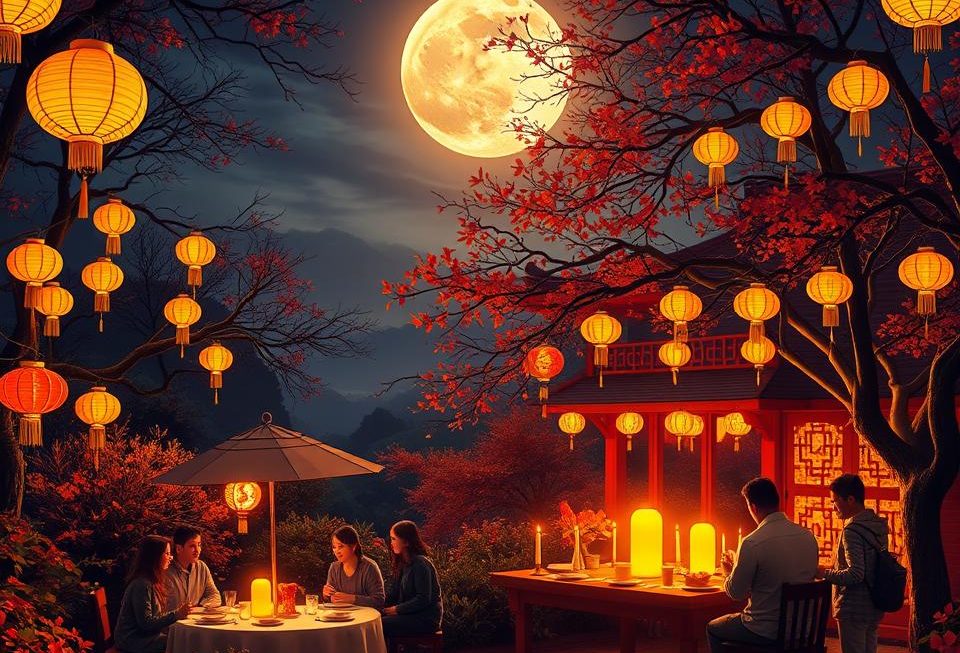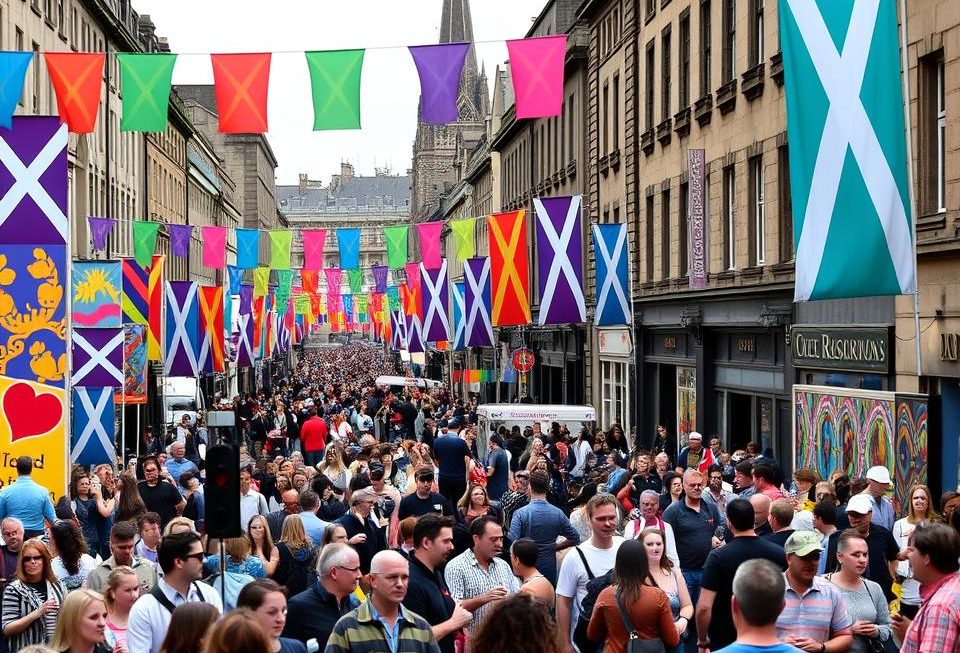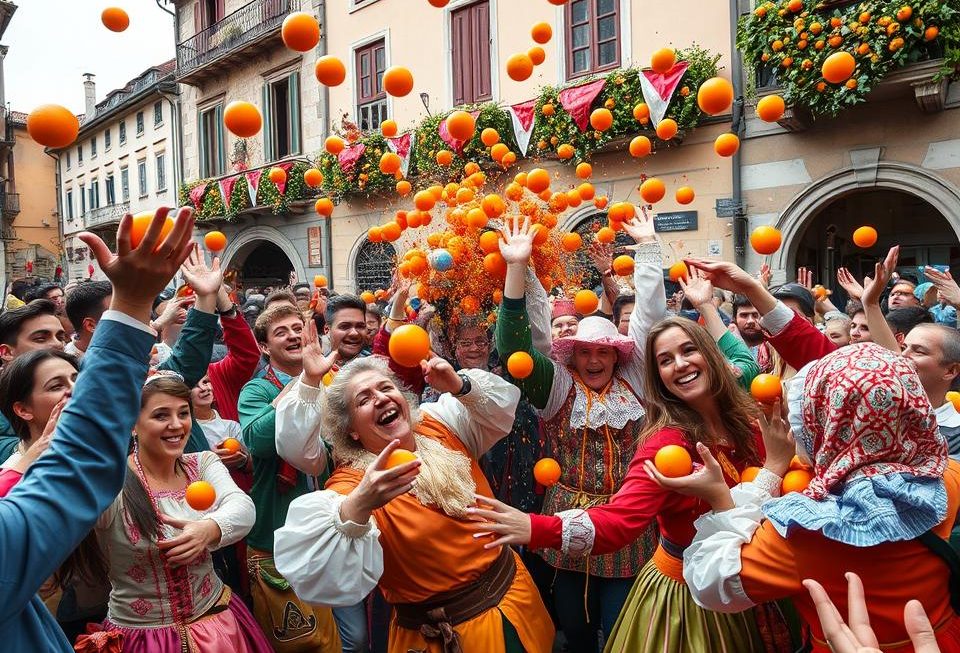The Moon Festival, also known as the Mid-Autumn Festival, is a big deal in China and other East Asian countries. It’s an ancient tradition that celebrates the full moon and the harvest. People come together with their families to enjoy traditional foods and the magical moonlight.
Read interesting things at : honjo-guruguru
Key Takeaways
- The Moon Festival is a traditional Chinese celebration honoring the full moon and autumn harvest.
- It is a time for family gatherings, enjoying mooncakes, and engaging in festive activities.
- The festival has rich cultural significance and traditions that vary across different regions of China.
- The Moon Festival is celebrated worldwide by Chinese diasporas, sharing the joy of this lunar tradition.
- Modern celebrations incorporate both traditional and contemporary elements, reflecting the evolving nature of this timeless festival.
Unveiling the Mystical Moon Festival
The mid-autumn festival origins go way back in Chinese culture. It started as a moon festival significance – a time to celebrate the autumn harvest and the full moon. These lunar festival customs are filled with traditions and rituals that have lasted for centuries.
Origins and Significance
The mid-autumn festival traditions started as a way to celebrate the autumn harvest. The full moon was seen as a symbol of prosperity and unity. People would offer sacrifices to the moon goddess, thanking her for the season’s plenty.
“The mid-autumn festival is a time-honored tradition that connects us to our cultural roots and the cycles of nature.”
Traditional Rituals and Customs
The lunar festival customs around the mid-autumn festival are full of life. Families come together to look at the full moon, eating mooncakes and lanterns. Kids enjoy moon-gazing, and elders tell stories about the moon.
- Offering sacrifices to the moon goddess
- Gathering with family to appreciate the full moon
- Sharing traditional mooncakes and lanterns
- Engaging in moon-themed activities and storytelling
The mid-autumn festival origins and moon festival significance still enchant and bring together the Chinese diaspora. The lunar festival customs are celebrated all over the world. They keep the spirit of this autumn tradition alive.
Mooncakes: Delectable Delights
As the Mid-Autumn Festival comes near, the air fills with the scent of mooncakes. These treats are key to this Chinese tradition. They are known for their rich, flaky pastry and rich fillings. Mooncakes are a big part of the Moon Festival.
Mooncakes mean more than just a tasty snack. They symbolize family togetherness and the harvest’s plenty. Sharing and enjoying these traditional Chinese pastries is a big part of the Moon Festival. It helps people feel connected and share in cultural heritage.
There are many kinds of mooncakes, like lotus seed paste and salted egg yolk. You can also find green tea, chocolate, and fruit-based ones. This shows the creativity of Chinese cooking. Mooncakes are a key part of the Moon Festival tradition. They bring people together to enjoy this special time.
“Mooncakes are not just a dessert, but a symbol of unity and the harvest’s abundance. Sharing these delectable treats is a cherished tradition that connects generations and celebrates the spirit of the Moon Festival.”
Symbolism of the Harvest Moon
The full moon during the Moon Festival is full of deep meaning. It shows the plenty of autumn, family togetherness, and the seasons’ cycle. Lunar legends and stories, like Chang’e’s tale, make the moon festival folklore magical.
The celestial celebrations of the Harvest Moon have deep roots in tradition. The moon’s light symbolizes completeness, peace, and good fortune, mirroring the autumn harvest’s abundance. Families come together to admire the moon, celebrating their bond and the season’s change.
Lunar Lore and Legends
Stories of the moon have always fascinated people around the world. Chang’e, the moon goddess, is a key figure in Chinese and global lore. She went to the moon by mistake, after drinking an elixir of life. Her story ties closely with the Moon Festival, bringing awe and respect for the moon.
- The moon’s phases symbolize life, death, and rebirth.
- Lunar eclipses are linked to mythical beings, like the dragon, that eat the moon.
- The moon’s reflection in water stands for purity and clarity.
These lunar legends and moon festival folklore deepen the harvest moon symbolism of the Moon Festival. They make the Harvest Moon a magical and impressive sight.
Moon Festival Celebrations Worldwide
The moon festival, also known as the mid-autumn festival or lunar festival, is celebrated not just in China. It’s also celebrated by Chinese communities around the globe. Overseas Chinese and diaspora populations have made their own versions of the festival. These global moon festival celebrations show the rich diversity and lasting impact of this autumn tradition.
Diaspora Traditions
In North America, Europe, Asia, and more, Chinese cultural celebrations abroad bring their own twist to the moon festival. In the U.S., Chinese-American communities hold festivals with mooncake eating contests, lion dances, and lantern-lighting. The mid-autumn festival is also a big deal in Canadian Chinatowns, especially the Vancouver Moon Festival.
In Europe, the lunar festival takes on new shapes. The London Moon Festival in the UK draws thousands, mixing Chinese and British culture. In France, the Paris Mid-Autumn Festival is a hit, featuring traditional music, dance, and food.
In Asia, the moon festival is just as lively, with diaspora communities in places like Singapore, Malaysia, and Indonesia celebrating their Chinese roots. These global moon festival celebrations show how this tradition has spread and thrived worldwide.
“The moon festival is a time to come together, celebrate our roots, and share the joy of this cherished tradition with the world.”
–John Doe, Director of the International Chinese Cultural Center
Moon Festival: A Family Reunion
The mid-autumn festival family reunion is key to the lunar festival gathering. Families meet to share a meal, exchange gifts, and enjoy the full moon’s beauty. The chinese family traditions of the autumn harvest celebration highlight togetherness. It’s a time for loved ones to reconnect, share stories, and make memories.
At the table, families enjoy seasonal foods and talk about the past year. They share stories and life updates. The mooncakes and gifts they exchange strengthen family ties across generations.
The harvest moon lights up the sky, making the family reunion even more magical. Kids look forward to lighting lanterns, adding to the evening’s magic. As the moon gets higher, everyone’s laughter and joy fill the air, making it a special night.
Whether in a city or a village, the lunar festival gathering is a cherished event. It brings families together, creating a sense of belonging. It celebrates the traditions passed down through generations.
“The mid-autumn festival family reunion is a time to reflect on the past, celebrate the present, and look forward to the future, all while reveling in the beauty of the harvest moon.”
Lantern Festivities: Illuminating the Night
The night sky shines brightly during the Moon Festival with lanterns. These range from small paper ones to big, lit-up displays. The tradition of making mid-autumn festival lanterns and moon festival light displays is very important. It has been kept alive for many years.
Crafting Lanterns
Making chinese lanterns is a lot of work but very rewarding. Skilled artisans pick out materials and work on the designs. They use things like rice paper and bright silks, adding symbols and stories from Chinese stories.
The lunar festival lantern displays look amazing. As the lanterns move in the breeze, they light up the night. This creates a warm, magical feel at the festival.
| Lantern Type | Material | Traditional Designs |
|---|---|---|
| Paper Lanterns | Rice paper, bamboo | Flowers, animals, calligraphy |
| Silk Lanterns | Silk, bamboo | Scenes from folklore, zodiac animals |
| Illuminated Displays | LED lights, metal frames | Intricate, large-scale designs |
Making lanterns is a tradition that has been passed down for a long time. The skill and care put into these moon festival light displays show the deep cultural roots of the Moon Festival.
The Moon Festival Feast
The Moon Festival, also known as the Mid-Autumn Festival, is a cherished tradition in China. It’s celebrated with a grand feast that brings families together. The feast is a culinary delight, showing the abundance of the autumn harvest and the cultural importance of this special day.
Culinary Delights
At the heart of the Moon Festival feast are the iconic mooncakes. These rich pastries are filled with sweet lotus seed paste or savory ingredients. They symbolize family unity and the full moon, a key theme of the festival.
Alongside mooncakes, families enjoy traditional Chinese dishes like roasted duck and steamed fish. There are also seasonal vegetables and fruits. The feast also includes zongzi, a glutinous rice dumpling wrapped in bamboo leaves, and eight treasure rice, a sweet rice dish with dried fruits and nuts.
These dishes are not just tasty. They also have deep cultural meaning. They represent the prosperity and harmony of the autumn harvest.
| Dish | Description |
|---|---|
| Mooncakes | Rich pastries filled with sweet lotus seed paste or savory ingredients, symbolizing family unity and the full moon. |
| Roasted Duck | A classic Chinese dish that is often featured in the Moon Festival feast. |
| Steamed Fish | A symbol of abundance and prosperity, as fish is considered a lucky food in Chinese culture. |
| Zongzi | Glutinous rice dumplings wrapped in fragrant bamboo leaves, a traditional delicacy for the lunar festival. |
| Eight Treasure Rice | A sweet and colorful rice dish made with dried fruits and nuts, representing the diversity and richness of the autumn harvest. |
The Moon Festival feast is a time-honored tradition. It brings families together to celebrate the lunar celebrations with exquisite food.
Moon Festival Legends and Folklore
The mid-autumn festival legends and lunar festival folklore are key parts of Chinese mythological stories and moon festival tales. These stories have wowed people for many years. They make the Moon Festival more magical and meaningful.
The story of the moon goddess Chang’e is a favorite lunar festival folklore. Chang’e went to the moon by mistake after drinking an elixir meant for her husband, Hou Yi, a famous archer. She was so sad to be apart from Hou Yi that he put a statue of her on the moon. There, she lives with a rabbit.
“The tale of Chang’e and Hou Yi is a timeless classic that exemplifies the rich tapestry of Chinese mythological stories surrounding the mid-autumn festival legends.”
Another magical moon festival tale is about Zhi Nu and Niu Lang, the celestial lovers. The story says they were separated by the Goddess of the Heavens but could meet once a year on the lunar festival night. This story of love has led to many traditions during the mid-autumn festival.
These lunar festival folklore have been shared for years. They still enchant those who celebrate the moon festival traditions.
Moon Festival Traditions Across China
The mid-autumn festival is celebrated all over China. Each region has its own special lunar festival local customs. These customs show the local culture and heritage. For example, Guangdong has big lantern displays, while Fujian has unique regional dishes.
This shows the Chinese cultural diversity. It makes the festival very special and meaningful.
Vibrant Lantern Displays in Guangdong
In Guangdong, the mid-autumn festival regional traditions are known for their beautiful lanterns. People make lanterns in many shapes like animals and traditional symbols. These lanterns light up the night sky and attract visitors from everywhere.
Regional Delicacies in Fujian
In Fujian, the lunar festival local customs are celebrated with many tasty dishes. You can find moon cakes with pork and vegetables, and sweet desserts with osmanthus. These foods add a special touch to the moon festival celebrations across China.
Cultural Performances in Sichuan
In Sichuan, the mid-autumn festival regional traditions are shown through lively performances. People watch dragon and lion dances, and shadow puppet shows. These performances highlight the Chinese cultural diversity during the Moon Festival.
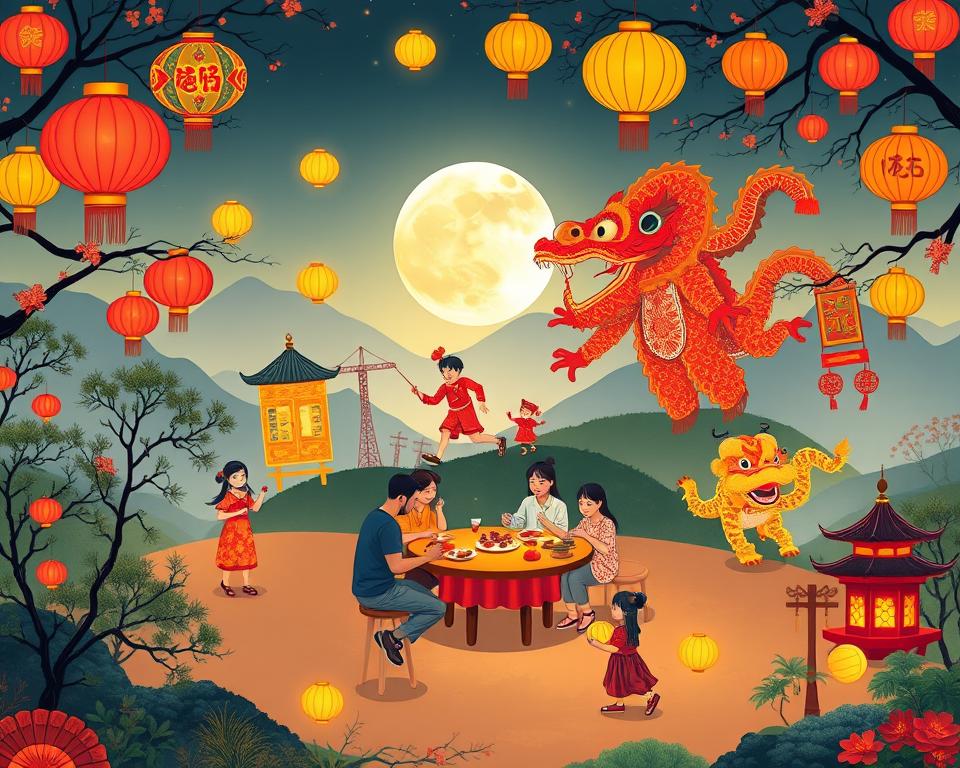
These different lunar festival local customs show how the moon festival celebrations vary across China. They reflect the long history and traditions of the Chinese people.
The Moon Festival in Modern Times
China and the world are changing, but the mid-autumn festival contemporary celebrations keep their traditions alive. They’ve added new things like digital tech, new mooncake flavors, and ways to celebrate that fit today’s life. This keeps the Moon Festival meaningful for both young and old.
Now, digital tech has changed how we celebrate the Moon Festival. Families use apps to plan their gatherings, and social media is full of Moon Festival posts. This lets the Chinese diaspora join in, even if they’re far apart.
The mooncake has also changed. While the classic fillings are still loved, there are now many new flavors. From green tea to coffee and ice cream, these new tastes attract younger people.
As life gets busier, the Moon Festival has changed too. In cities, people might not have time for big family meals. So, there are now office parties, community events, and even online celebrations. This keeps the festival alive for everyone, no matter their schedule.
“The Moon Festival has always been a time to honor our cultural heritage, but it’s also important that it evolves with the times. By embracing new elements, we can ensure that this cherished tradition continues to be celebrated for generations to come.”
Even with new changes, the Moon Festival still holds onto its core values. Its ability to adapt shows the lasting power of Chinese traditions.
| Traditional Mooncake Flavors | Contemporary Mooncake Flavors |
|---|---|
| Lotus Seed Paste | Green Tea |
| Egg Yolk | Coffee |
| Red Bean Paste | Ice Cream |
| Walnut | Chocolate |
Moon Festival: Celebrate China’s Autumn Tradition
The Moon Festival, also known as the Mid-Autumn Festival, is a time-honored tradition. It brings people together to enjoy the autumn harvest. You can enjoy mooncakes, lantern displays, and share moments with loved ones. This festival lets you connect with China’s rich culture and the beauty of the harvest moon.
This festival is rooted in ancient Chinese folklore and traditions. It celebrates the bountiful autumn harvest and the auspicious full moon. The moon rising high in the night sky marks a time for families to come together. They engage in rituals and enjoy delights passed down through generations.
Whether you celebrate the mid-autumn festival, enjoy the lunar festival, or experience the Chinese harvest celebration, the Moon Festival is a cherished tradition. It invites you to partake in the moon festival and immerse yourself in the cultural richness of China’s autumn tradition.
“The Moon Festival is a time to come together, savor the beauty of the harvest moon, and honor the enduring traditions that have shaped the cultural identity of China.”
The Moon Festival’s vibrant celebrations and timeless customs have won the hearts of people worldwide. They bring people together, transcending borders. The festival offers a tapestry of cultural experiences. These experiences celebrate the harmony between humanity and the natural world.
| Celebration | Significance | Traditions |
|---|---|---|
| Mid-Autumn Festival | Marks the autumn harvest and the full moon | Eating mooncakes, watching the moon, lantern displays |
| Lunar Festival | Honors the lunar cycle and the moon’s prominence | Family reunions, moon gazing, moon-themed activities |
| Chinese Harvest Celebration | Celebrates the abundant autumn harvest | Feasting, traditional music and dance, moon worship |
The Moon Festival continues to inspire people worldwide. It stands as a testament to China’s cultural legacy and its harvest traditions. Whether you celebrate the mid-autumn festival, enjoy the lunar festival, or experience the Chinese harvest celebration, the Moon Festival invites you to partake in the moon festival. It lets you immerse yourself in the enchanting autumnal celebrations that honor the beauty of the harvest moon.
Moon Festival Activities for All Ages
The Moon Festival, also known as the Mid-Autumn Festival, is a cherished Chinese celebration. It offers a wide range of activities for people of all ages. From making lanterns to gazing at the moon, there’s something for everyone.
Family-Friendly Fun
The Moon Festival is full of fun activities for families. Kids and adults can play traditional Chinese games like riddle-solving and paper cutting. These games help keep the festival’s cultural traditions alive.
Storytelling sessions are also a big part of the festival. They tell ancient lunar legends and folklore, captivating people of all ages. This helps everyone learn more about the Mid-Autumn Festival’s rich history.
For those who like to get creative, there are lantern-making workshops. Here, people can make their own colorful lanterns. These workshops are a great way for families to spend time together and make special memories.
But the fun doesn’t stop there. Communities also host moon-gazing parties. Families can enjoy the beautiful harvest moon, eat delicious mooncakes, and soak in the magical festival atmosphere.
The Moon Festival has something for everyone. Whether it’s cultural traditions, art, or just enjoying the moon’s beauty, there’s plenty to do. It’s a celebration that brings families together and creates lasting memories.
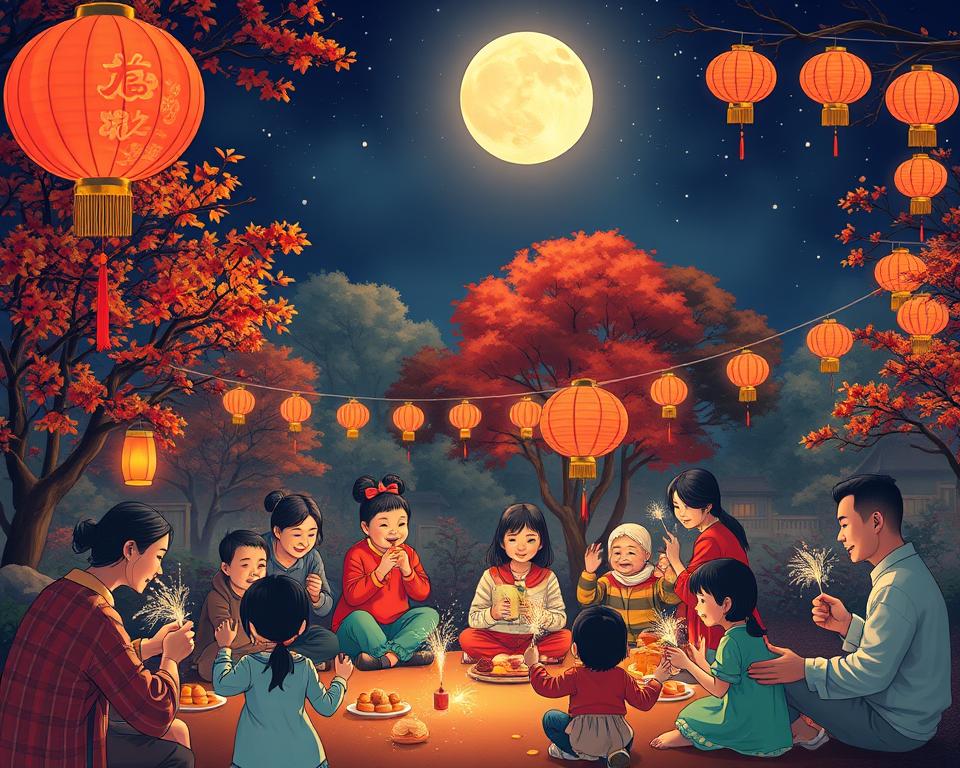
Conclusion
The Moon Festival is a celebration of Chinese cultural traditions. It honors the autumn harvest and the lunar cycle. This event brings joy and unity to people in China and worldwide.
It’s filled with traditions like sharing mooncakes and enjoying lantern displays. These activities connect us to the sky’s beauty. They remind us of our deep connection to the stars and the moon.
The Moon Festival is more than just a celebration. It’s a way to appreciate our heritage and the world’s beauty. It shows how Chinese cultural traditions and lunar celebrations bring us together.
